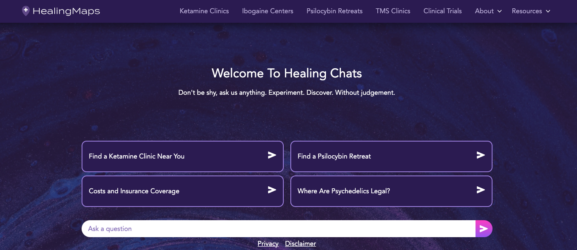The Differences Between Ketamine-Assisted Therapy (KAT) and Ketamine-Assisted Psychotherapy (KAP)
With over 2,500 ketamine clinics in the United States, there is a wide range of treatment options available. Some clinics offer just ketamine infusions, while others offer a therapy component of their ketamine protocol. But which one is right for you? Here we break down the differences between ketamine-assisted therapy (also known as KAT) and ketamine-assisted psychotherapy (also known as KAP). Additionally, we’ll also contrast these two treatments with regular ketamine infusions that offer no therapy component.
Ketamine-Assisted Therapy (KAT) vs Ketamine-Assisted Psychotherapy (KAP) — As Well As Non-Therapy Infusions
| Aspect | Ketamine-Assisted Therapy (KAT) | Ketamine-Assisted Psychotherapy (KAP) | Ketamine Infusions (No Therapy) |
| Definition | KAT uses ketamine to support traditional therapy methods, focusing on the drug’s ability to create a conducive mental state for treatment. | KAP integrates ketamine use with psychotherapy, utilizing the altered state induced by ketamine to enhance and deepen the psychotherapeutic process. | Ketamine infusions refer to the medical administration of ketamine, primarily focusing on the biological and neurochemical effects to treat conditions like depression or chronic pain. |
| Therapeutic Approach | Combines traditional therapeutic methods with ketamine’s effects, but the focus can be more on symptom relief than psychotherapeutic exploration. | Emphasizes psychotherapeutic techniques during the ketamine experience, aiming for psychological insight and emotional healing. | Focuses solely on the pharmacological impact of ketamine, without incorporating psychotherapeutic techniques. |
| Role of Mental Health Professionals | Mental health professionals are involved but may focus more on overseeing the medical safety and symptom management. | Therapists play an active role in guiding the patient through the psychotherapeutic process during and after ketamine administration. | Health professionals are primarily involved in administering the drug and monitoring the patient’s physical response, with less emphasis on mental health support. |
| Setting | Can be administered in a clinical setting, therapy office, or a controlled medical environment. | Usually conducted in a therapeutic setting conducive to psychotherapy, such as a therapist’s office or a specialized clinic. | Typically administered in a medical clinic or hospital setting, focusing on the medical aspects of treatment. |
| Integration of Experience | May or may not include integration sessions to process the ketamine experience. | Integration of the ketamine experience with the patient’s psychological state is a core component. | Generally does not include dedicated sessions to integrate the experience into the patient’s psychological understanding. |
| Treatment Goal | Aims to alleviate symptoms of mental health disorders, with varying degrees of therapeutic exploration. | Focuses on emotional and psychological healing, personal growth, and symptom relief through an integrative psychotherapeutic approach. | Primarily targets symptom relief, especially in cases of treatment-resistant conditions, with a focus on biological and neurological effects. |
| Duration and Structure | Varies based on the treatment plan and patient’s response. | Usually has a more structured approach combining psychotherapy with a set number of ketamine sessions. | Typically consists of a series of infusions following a medical protocol, with duration and frequency based on clinical guidelines. |
Why Ketamine?
Ketamine, an FDA-approved powerful anesthetic, has found new roles in mental health care. It forms the core of Ketamine-Assisted Psychotherapy (KAP) and Ketamine-Assisted Therapy (KAT). These two therapies, while similar in name, differ significantly in approach and execution.
RELATED: Where is Ketamine Legal in 2024
Ketamine-Assisted Therapy (KAT) vs Ketamine-Assisted Psychotherapy (KAP) — A Deeper Dive
KAP integrates ketamine use with in-depth psychotherapy. It primarily targets individuals seeking deep psychological change. KAT, on the other hand, uses ketamine to enhance traditional therapy. It focuses more on alleviating specific symptoms.
The core of KAP lies in its psychotherapeutic process. Here, therapists actively guide patients through their experiences under ketamine. This approach aims to unlock psychological insights and emotional healing. Patients delve into their subconscious, exploring thoughts and feelings in a unique state of consciousness.
The Chemical Combined with the Therapeutic
In contrast, KAT places less emphasis on psychotherapeutic exploration. It combines ketamine’s biochemical benefits with standard therapeutic techniques. The therapist’s role is often more observational. They ensure the patient’s safety and comfort while ketamine does its work.
KAP sessions are carefully structured. They include pre-session preparation, ketamine administration, and post-session integration. Each stage is crucial. Patients prepare mentally and emotionally before receiving ketamine. They then undergo a guided exploration of their psyche during the session. Integration afterward helps them make sense of the experience.
Ketamine-Assisted Therapy (KAT) vs Ketamine-Assisted Psychotherapy (KAP) — Structure and Flexbility
KAT lacks this structured approach. Its focus is more flexible, adapting to individual needs and responses. Ketamine administration in KAT aids in making therapy sessions more effective. It helps in reducing symptoms like depression or anxiety. Yet, there is less focus on the transformative psychological journey seen in KAP.
Integration forms a significant part of KAP. This phase helps patients assimilate insights gained during the altered state. It is crucial for translating these experiences into meaningful life changes. KAT might include some form of integration. However, it is not as central to the treatment as in KAP.
Both KAP and KAT require trained professionals. Yet, the skill sets differ. KAP practitioners need expertise in psychotherapy and experience in guiding altered states of consciousness. KAT practitioners focus more on the clinical aspects of ketamine administration.
Outcomes and Goals
The choice between KAP and KAT depends on the patient’s goals. Those seeking deep psychological change might prefer KAP. Its psychotherapeutic focus offers a pathway to profound personal growth. Individuals aiming for symptom relief might find KAT more suitable. It offers the therapeutic benefits of ketamine with less emphasis on psychological exploration.
In summary, KAP and KAT use ketamine to aid mental health treatment. KAP stands out for its psychotherapeutic depth and structured approach. KAT focuses on symptom relief through a combination of ketamine and traditional therapy. Both have their place in modern mental health care. They cater to different needs and treatment objectives.



